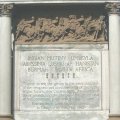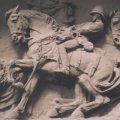|
 |
|
| |
 |
|  |
|
Details:
|
|
|
Sculptor:
Harry Bates
(1850-1899).
Location: Kelvingrove Park, Glasgow.
Date executed: 1916 (copied from original in Calcutta, India, 1894-8).
Executed by:
Henry Poole
(1873-1928)
|
|



| |
Lord Frederick Sleigh Roberts, of Khandahar, Pretoria and
Waterford (1832-1914), was the Wellington
of the late Victorian era.
The saviour of the British Empire and its honour on a number of occasions
in the perpetual colonial wars fought throughout Queen Victoria's reign.
A national hero by the time he took Glasgow by storm on his first visit
to the city in 1903, he had recently subdued the Boers in South Africa
and had already become a legend with his epic retreat from Khabul to
Khandahar during the Afghan War of 1878.
|



| |
Bobs, as he was popularly known, was immortalised in bronze in
Calcutta by
Harry Bates
after a grateful empire decided to honour
its greatest living hero and Commander-in-Chief of its Indian army
(1885-93), in 1894.
Erected on the city's Maidan
, Lady Robert's confirmed
that the likeness was better than the real thing, and no less an
authority than the celebrated artist George Frederick Watts
declared
it the finest equestrian statue of the age.
|

| |
The monument was completed in 1898,
after
Bates
had included a dramatic, narrative frieze
illustrating
the Afghan campaign at his own expense with the intention that
the portrait should be viewed as the culmination of an aesthetic
experience that should begin at the base of the pedestal, rather
than being viewed as a horse and rider mounted on a convenient block
of granite. The Baroque
, silver-grey, granite pedestal was produced
by the London architect Edwin Alfred Rickards.
|



| |
After Roberts' second visit to Glasgow in 1913, World War I became
the cause for which the empire looked to Roberts to win. However,
whilst visiting the troops in France after the equally celebrated
retreat from the Marne in Augst 1914, he contracted pneumonia and
died. Glasgow Corporation lost no time in opening a subscription fund
for a public monument to him.
|



| |
Setting about the business in the usual fashion, a committee was
formed to secure an eminent sculptor for the job and an open
competition was considered as the means of securing him. They were saved the trouble, however, by
Bates
' and Roberts' widows, who suggested that
the most fitting tribute (and most convenient and inexpensive) would
be to erect a copy of the Calcutta statue, and that the sculptor's
former apprentice
Henry Poole
, who had assisted
Bates
on the original, and who was an eminent sculptor in his own right, should be given the job.
|


| |
Faithful in every detail (except the pedestal inscriptions) to its
Calcutta model, Roberts is depicted wearing his favourite
forage jacket and pith helmet, and mounted on Volonel, his Arabian
charger.
Volonel had carried Robert's throughout his later campaigns
and in Queen Victoria's Diamond Jubilee procession in 1897. The horse was accorded a burial with full military honours after his death in
Dublin, in 1901.
|






| |
The figurative, processional frieze
around the top of the pedestal
illustrates Roberts' epic Khabul retreat and the Horse Artillery,
Native Cavalry, Highland Regiments and Gurkhas
who accompanied him.
A tour-de-force of expressive modelling and dramatic narrative in
bronze, the frieze
confirms
Bates
' reputation as a consumate exponent
of the New Sculpture style.
|


| |
Active and latent expressions of Victory and War are
embodied in the 'book-end' figures seated at the east and west sides
of the pedestal.
|


| |
Victory is represented by a Classical, laurel
crowned maiden who
raises the Union Flag
towards Roberts, the
Victorian Mars.
She is seated on the prow of an ancient galley which was originally crested with a tiny group
of St George and the Dragon, until it was stolen in the 1970s. This miniature masterpiece can be seen
in photographs published in Susan Beattie's The New Sculpture (1983)
and James Drummond's Scots Magazine article about the monument, Has
Glasgow Got The Best (April, 1983, pp. 92-5).
|


| |
War is represented by a proud Moghul
warrior, seated on a native
cannon and dressed in traditional chain-mail tunic and helmet.
Homage is paid to the prowess of both armies in the Afghan War with
representations of their headgear (pith helmet and chain-mail helmets)
on the bronze capitals of the pedestal's columns. These surmount tiny shields
inscribed Virtue and Valour.
|



| |
Roberts' African and eastern campaigns are enumerated on the south
face of the pedestal, and his decorations illustrated with bronze
replicas, including the VC
which he won during the Indian Mutiny, 1858.
Also inscribed is an extract from a speech made during his last visit
to Glasgow in May, 1913, in which he foretold the empire's dependence
on an army of citizen soldiers for its survival; many of whom were in
the audience and who would perish as volunteers and conscripts in the
First and Second World Wars. The north face is inscribed with the
dedicatory details and also includes replicas of his other decorations.
|


| |
The unveiling ceremony on 21st August 1916, was attended by 500
soldiers and sailors and a garde d'honneur of veterans from Roberts'
campaigns. Also present were Lord Derby, the Under-Secretary for War, and
Viscount French, of Ypres, as well as a multitude of civilians and invited
dignitaries who crowded into Park Terrace to witness Roberts' daughter,
Countess Roberts, perform the unveiling ceremony (Lady Roberts had been invited to do the honours but she was laid up
with pneumonia and sciatica at the time). Throughout the ceremony a Royal Flying Corps biplane buzzed overhead.
|


| |
A further copy of the statue was made by Poole for London in 1924, which stands on Horse Guards Parade. This is exact in every way except for the pedestal, which is much smaller and without the narrative frieze, the seated figures and the original inscriptions, the new pedestal being inscribed simply 'ROBERTS'.
|

| |
Sources:
|
|
Click on an image to enlarge it.
|
Click here to return to the TOP.
|
|
|
All images and biographies are our copyright and may not be reproduced
in any form whatsoever without our express permission.
|
|
|
|
|
For sculpture and architecture: we have over 300 biographies of sculptors and architects connected with Glasgow, Scotland.
|
|
| Copyright 2001-2025 glasgowsculpture.com. |
|
|
| |
|
 |
|

